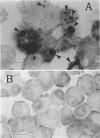Abstract
Antibiotic susceptibility testing of two isolates of the Q-fever agent, Coxiella burnetii, was performed with recently and persistently infected L929 fibroblast cells. The two genetically distinct isolates, Nine Mile and Priscilla, are implicated in two different clinical disease syndromes, acute and chronic Q fever, respectively. We compared the efficacies of rifampin, doxycycline, and five 4-quinolone compounds (ciprofloxacin, difloxacin, ofloxacin, norfloxacin, and pefloxacin) in reducing persistent C. burnetii infection of L929 fibroblasts. In persistently infected cells, the Priscilla isolate was less susceptible to all antibiotics tested when compared with the Nine Mile isolate. The most effective antibiotics against the Priscilla isolate were ofloxacin, pefloxacin, and ciprofloxacin (50% inhibitory concentrations of 0.5, 2.2, and 2.5 micrograms/ml, respectively). In persistently infected cells, the Nine Mile isolate was highly susceptible to all antibiotics tested except doxycycline. In contrast, the Priscilla and Nine Mile isolates in recently infected cells were somewhat susceptible to doxycycline; the Priscilla isolate was significantly more susceptible to ofloxacin and rifampin in recently infected host cells than in persistently infected cells. Persistently infected L929 cells were also treated with antibiotic combinations. Although ciprofloxacin and doxycycline had no synergistic effect on the Priscilla isolate, ciprofloxacin and rifampin acted synergistically. Collectively, these in vitro results are in accord with the fact that chronic Q fever in humans is generally not successfully managed with antibiotics. They also indicate that early diagnosis may be essential and that combination antibiotic therapy that includes quinolones may be effective in treating chronic Q fever.
Full text
PDF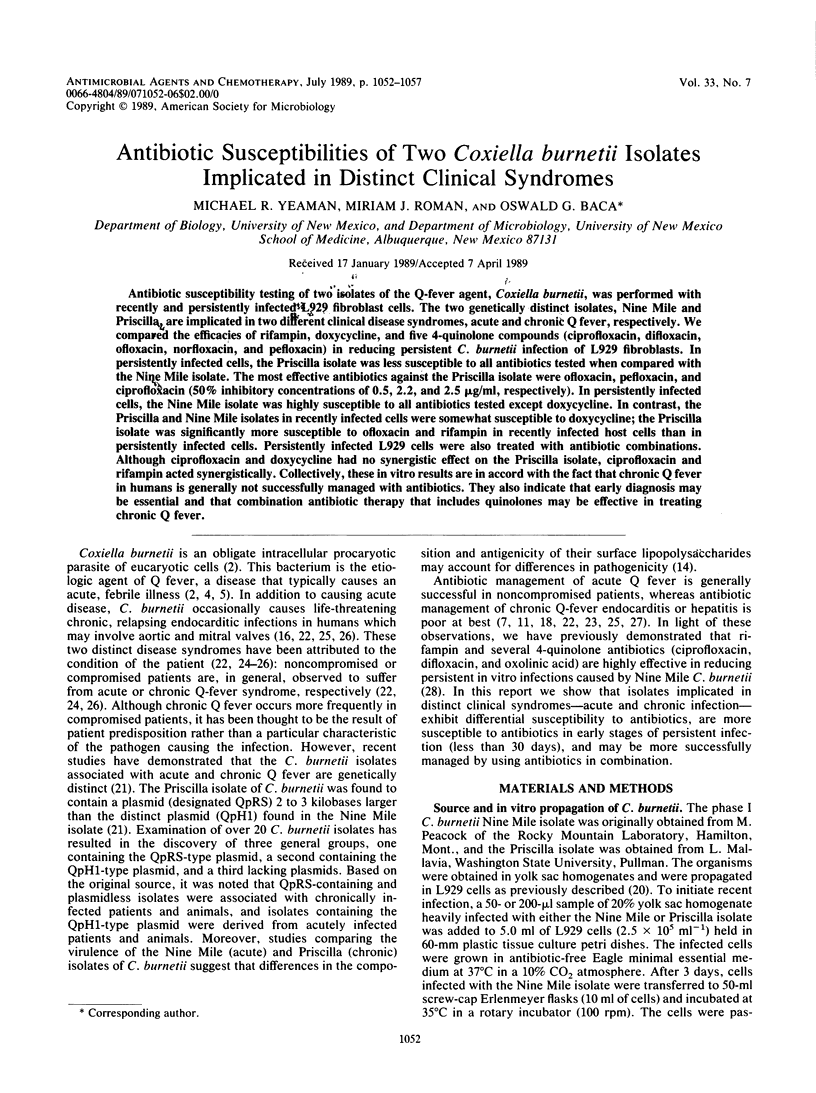
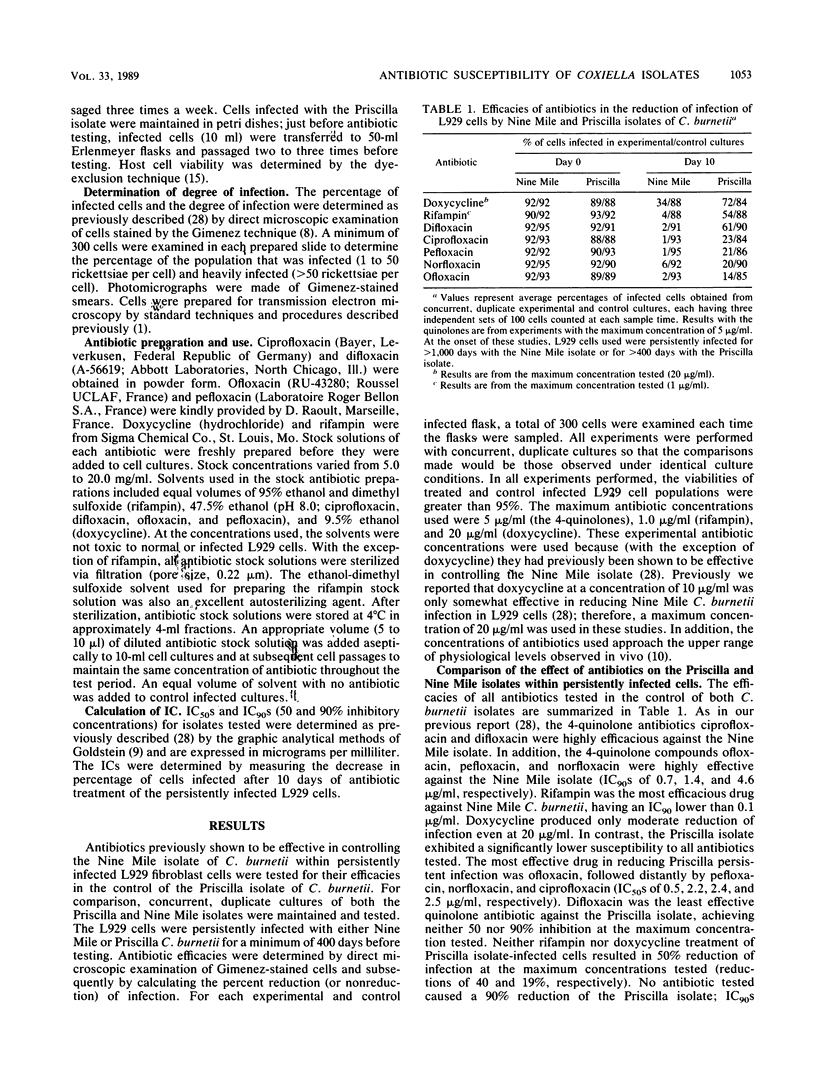
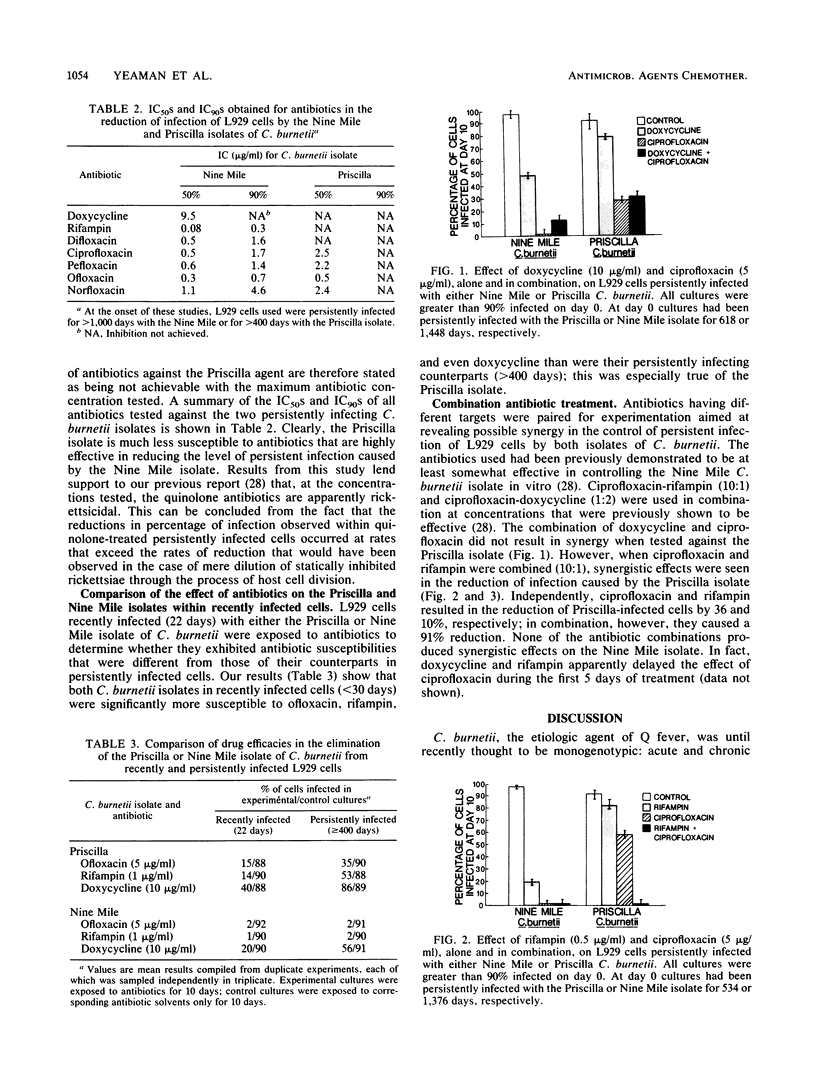
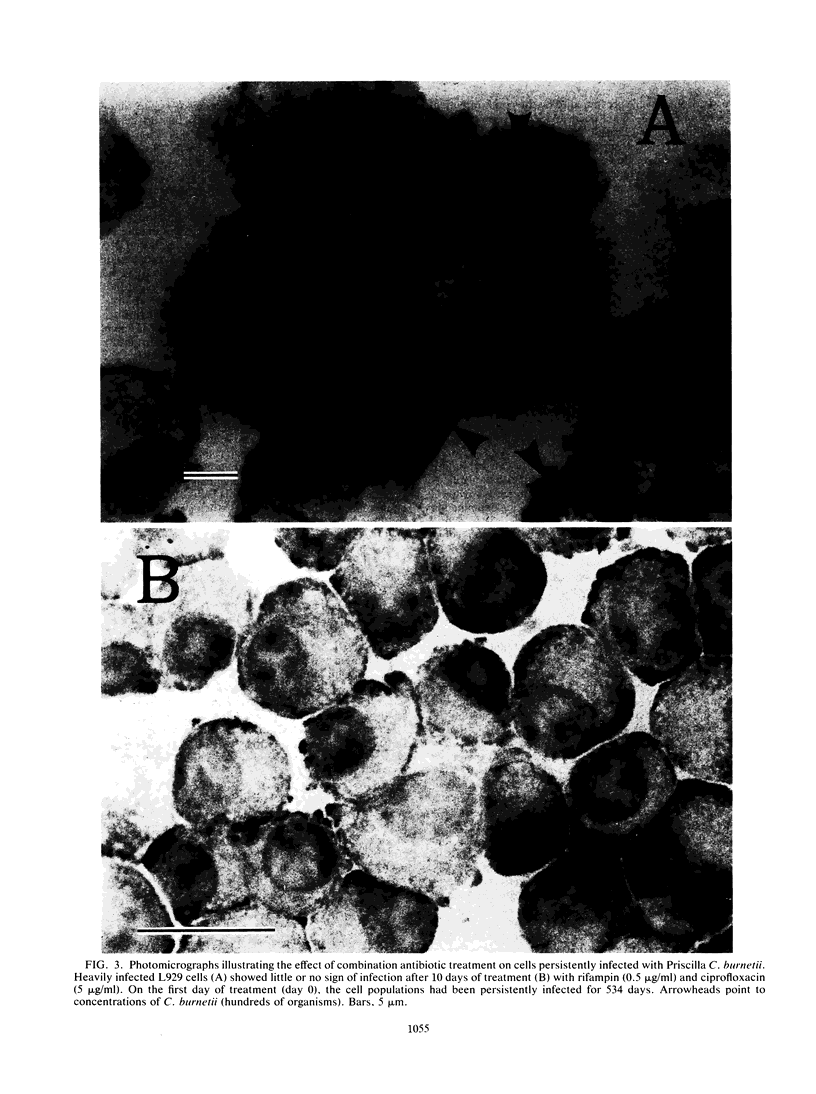
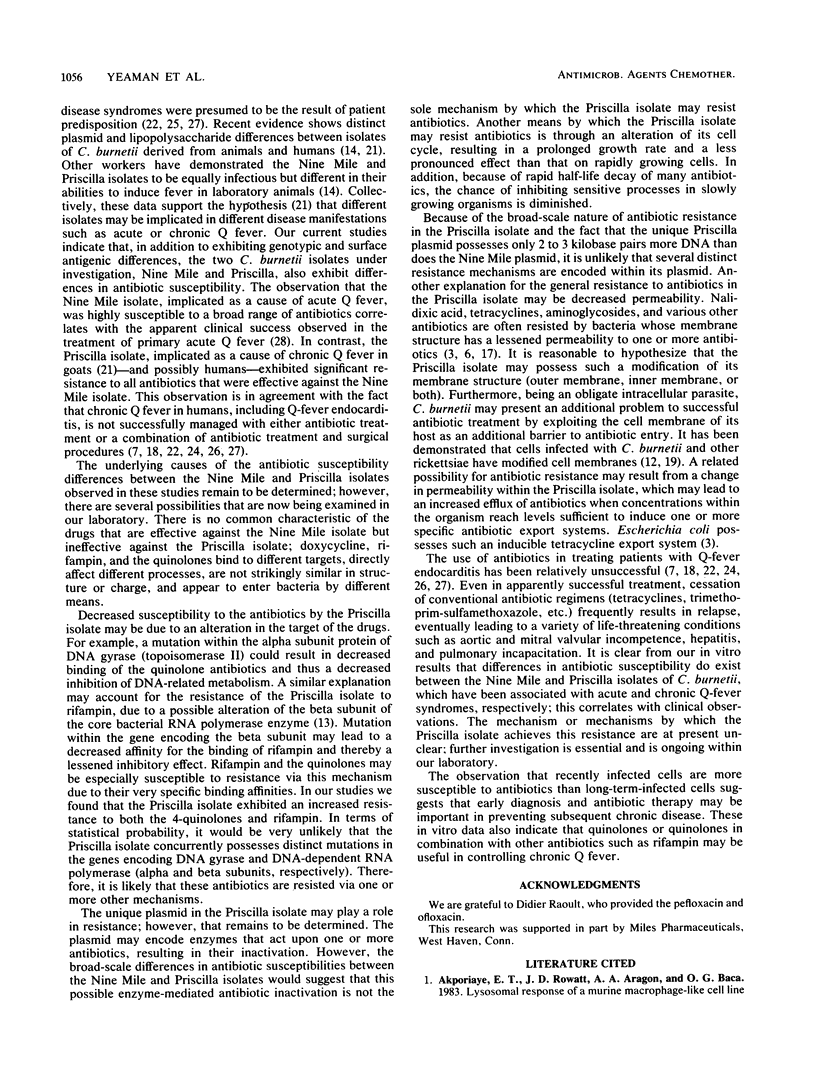
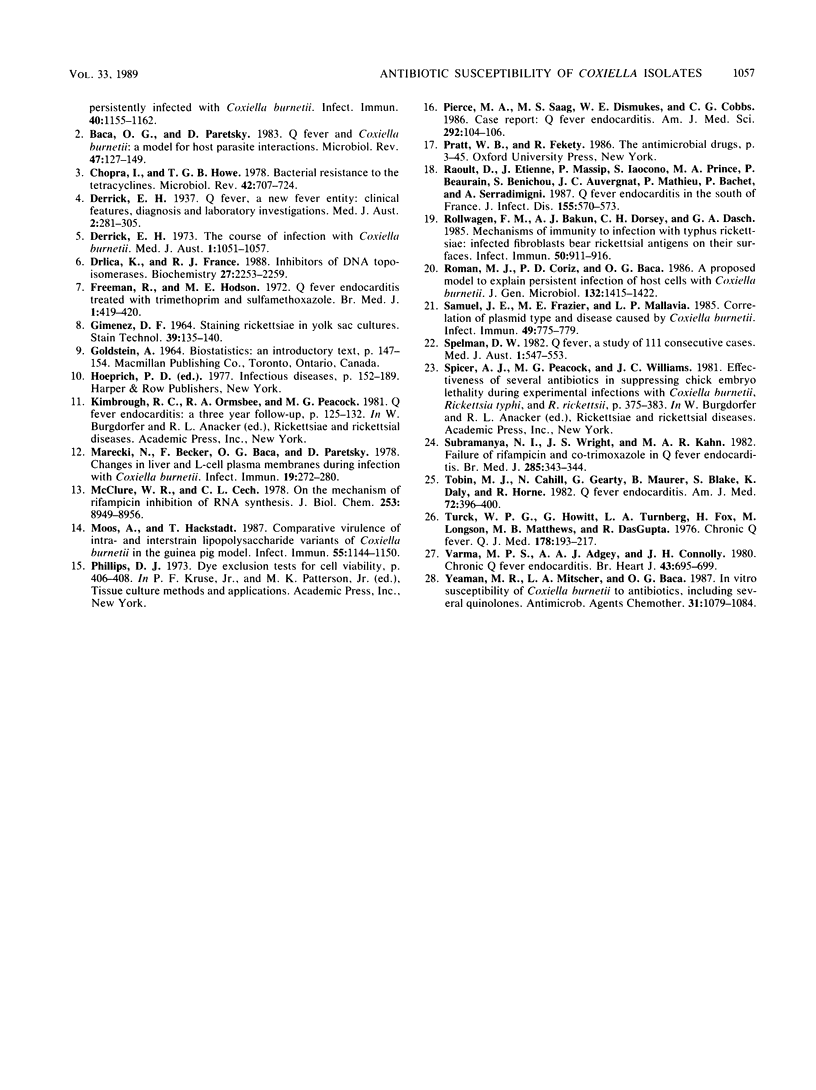
Images in this article
Selected References
These references are in PubMed. This may not be the complete list of references from this article.
- Akporiaye E. T., Rowatt J. D., Aragon A. A., Baca O. G. Lysosomal response of a murine macrophage-like cell line persistently infected with Coxiella burnetii. Infect Immun. 1983 Jun;40(3):1155–1162. doi: 10.1128/iai.40.3.1155-1162.1983. [DOI] [PMC free article] [PubMed] [Google Scholar]
- Baca O. G., Paretsky D. Q fever and Coxiella burnetii: a model for host-parasite interactions. Microbiol Rev. 1983 Jun;47(2):127–149. doi: 10.1128/mr.47.2.127-149.1983. [DOI] [PMC free article] [PubMed] [Google Scholar]
- Chopra I., Howe T. G. Bacterial resistance to the tetracyclines. Microbiol Rev. 1978 Dec;42(4):707–724. doi: 10.1128/mr.42.4.707-724.1978. [DOI] [PMC free article] [PubMed] [Google Scholar]
- Derrick E. H. The course of infection with Coxiella burneti. Med J Aust. 1973 May 26;1(21):1051–1057. [PubMed] [Google Scholar]
- Drlica K., Franco R. J. Inhibitors of DNA topoisomerases. Biochemistry. 1988 Apr 5;27(7):2253–2259. doi: 10.1021/bi00407a001. [DOI] [PubMed] [Google Scholar]
- Freeman R., Hodson M. E. Q fever endocarditis treated with trimethoprim and sulphamethoxazole. Br Med J. 1972 Feb 12;1(5797):419–420. doi: 10.1136/bmj.1.5797.419. [DOI] [PMC free article] [PubMed] [Google Scholar]
- GIMENEZ D. F. STAINING RICKETTSIAE IN YOLK-SAC CULTURES. Stain Technol. 1964 May;39:135–140. doi: 10.3109/10520296409061219. [DOI] [PubMed] [Google Scholar]
- Marecki N., Becker F., Baca O. G., Paretsky D. Changes in liver and L-cell plasma membranes during infection with Coxiella burnetii. Infect Immun. 1978 Jan;19(1):272–280. doi: 10.1128/iai.19.1.272-280.1978. [DOI] [PMC free article] [PubMed] [Google Scholar]
- McClure W. R., Cech C. L. On the mechanism of rifampicin inhibition of RNA synthesis. J Biol Chem. 1978 Dec 25;253(24):8949–8956. [PubMed] [Google Scholar]
- Moos A., Hackstadt T. Comparative virulence of intra- and interstrain lipopolysaccharide variants of Coxiella burnetii in the guinea pig model. Infect Immun. 1987 May;55(5):1144–1150. doi: 10.1128/iai.55.5.1144-1150.1987. [DOI] [PMC free article] [PubMed] [Google Scholar]
- Pierce M. A., Saag M. S., Dismukes W. E., Cobbs C. G. Q fever endocarditis. Am J Med Sci. 1986 Aug;292(2):104–106. doi: 10.1097/00000441-198608000-00007. [DOI] [PubMed] [Google Scholar]
- Raoult D., Etienne J., Massip P., Iaocono S., Prince M. A., Beaurain P., Benichou S., Auvergnat J. C., Mathieu P., Bachet P. Q fever endocarditis in the south of France. J Infect Dis. 1987 Mar;155(3):570–573. doi: 10.1093/infdis/155.3.570. [DOI] [PubMed] [Google Scholar]
- Rollwagen F. M., Bakun A. J., Dorsey C. H., Dasch G. A. Mechanisms of immunity to infection with typhus rickettsiae: infected fibroblasts bear rickettsial antigens on their surfaces. Infect Immun. 1985 Dec;50(3):911–916. doi: 10.1128/iai.50.3.911-916.1985. [DOI] [PMC free article] [PubMed] [Google Scholar]
- Roman M. J., Coriz P. D., Baca O. G. A proposed model to explain persistent infection of host cells with Coxiella burnetii. J Gen Microbiol. 1986 May;132(5):1415–1422. doi: 10.1099/00221287-132-5-1415. [DOI] [PubMed] [Google Scholar]
- Samuel J. E., Frazier M. E., Mallavia L. P. Correlation of plasmid type and disease caused by Coxiella burnetii. Infect Immun. 1985 Sep;49(3):775–779. doi: 10.1128/iai.49.3.775-779.1985. [DOI] [PMC free article] [PubMed] [Google Scholar]
- Spelman D. W. Q fever: a study of 111 consecutive cases. Med J Aust. 1982 Jun 26;1(13):547-8, 551, 553. doi: 10.5694/j.1326-5377.1982.tb124169.x. [DOI] [PubMed] [Google Scholar]
- Subramanya N. I., Wright J. S., Khan M. A. Failure of rifampicin and co-trimoxazole in Q fever endocarditis. Br Med J (Clin Res Ed) 1982 Jul 31;285(6338):343–344. doi: 10.1136/bmj.285.6338.343. [DOI] [PMC free article] [PubMed] [Google Scholar]
- Tobin M. J., Cahill N., Gearty G., Maurer B., Blake S., Daly K., Hone R. Q fever endocarditis. Am J Med. 1982 Mar;72(3):396–400. doi: 10.1016/0002-9343(82)90495-8. [DOI] [PubMed] [Google Scholar]
- Turck W. P., Howitt G., Turnberg L. A., Fox H., Longson M., Matthews M. B., Das Gupta R. Chronic Q fever. Q J Med. 1976 Apr;45(178):193–217. [PubMed] [Google Scholar]
- Varma M. P., Adgey A. A., Connolly J. H. Chronic Q fever endocarditis. Br Heart J. 1980 Jun;43(6):695–699. doi: 10.1136/hrt.43.6.695. [DOI] [PMC free article] [PubMed] [Google Scholar]
- Yeaman M. R., Mitscher L. A., Baca O. G. In vitro susceptibility of Coxiella burnetii to antibiotics, including several quinolones. Antimicrob Agents Chemother. 1987 Jul;31(7):1079–1084. doi: 10.1128/aac.31.7.1079. [DOI] [PMC free article] [PubMed] [Google Scholar]



